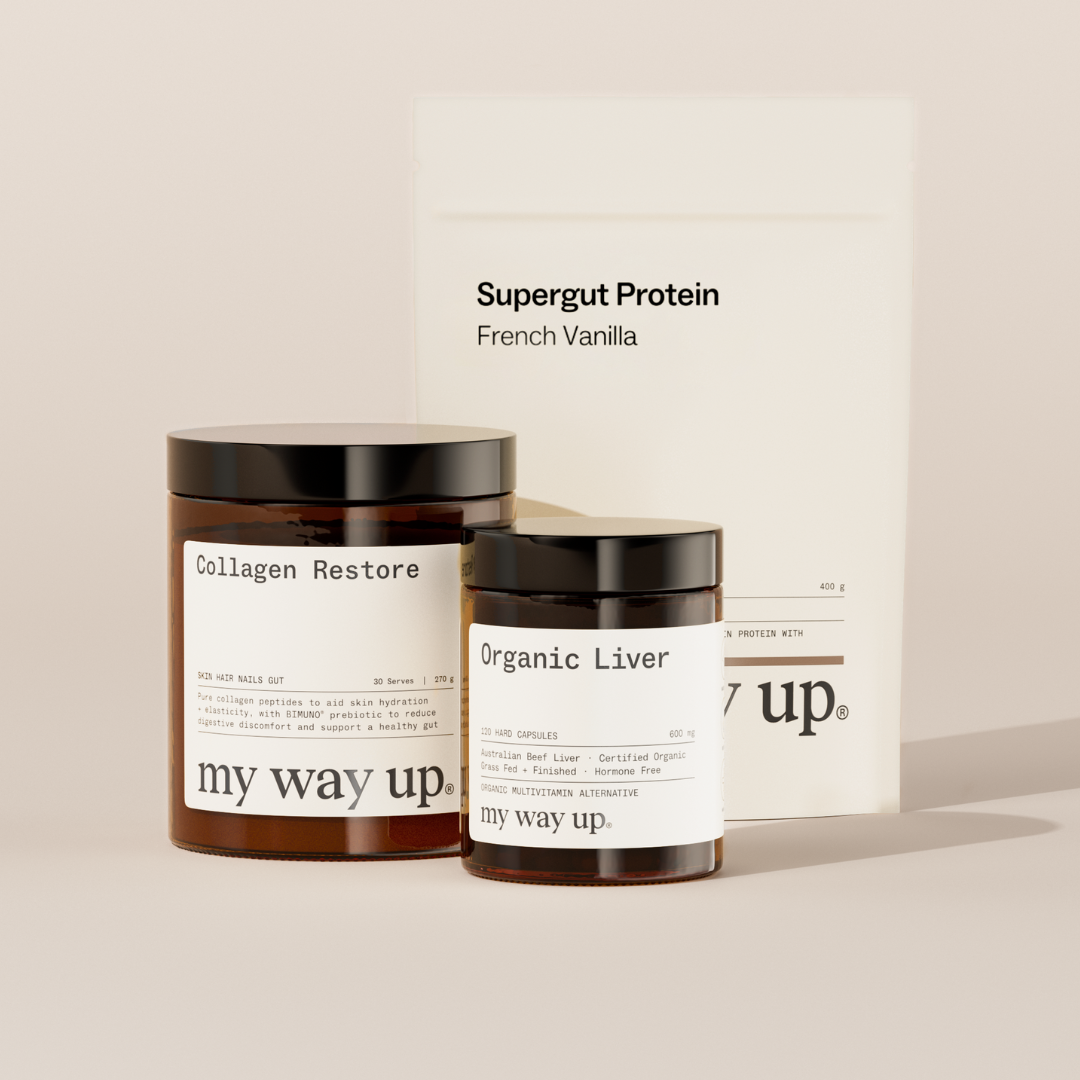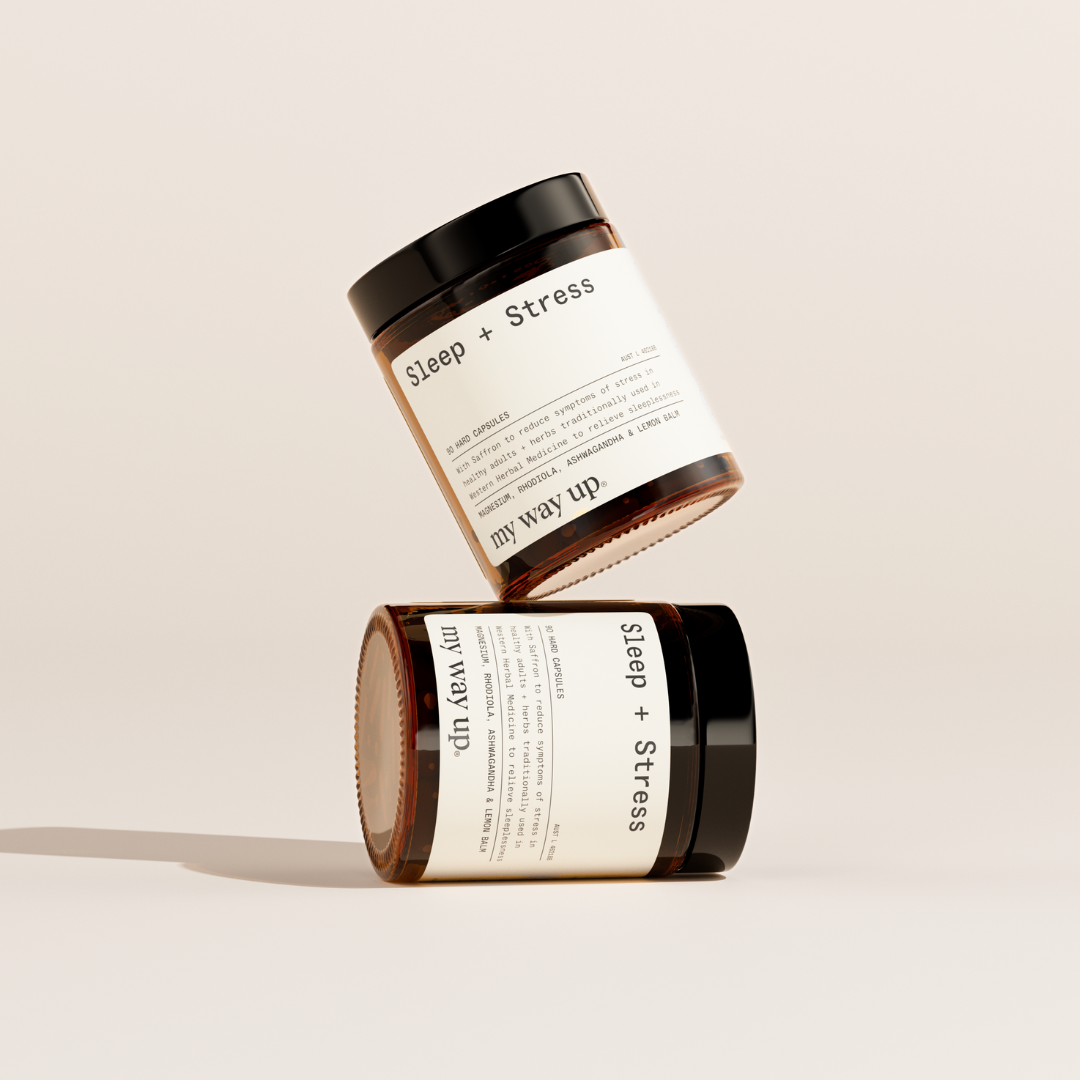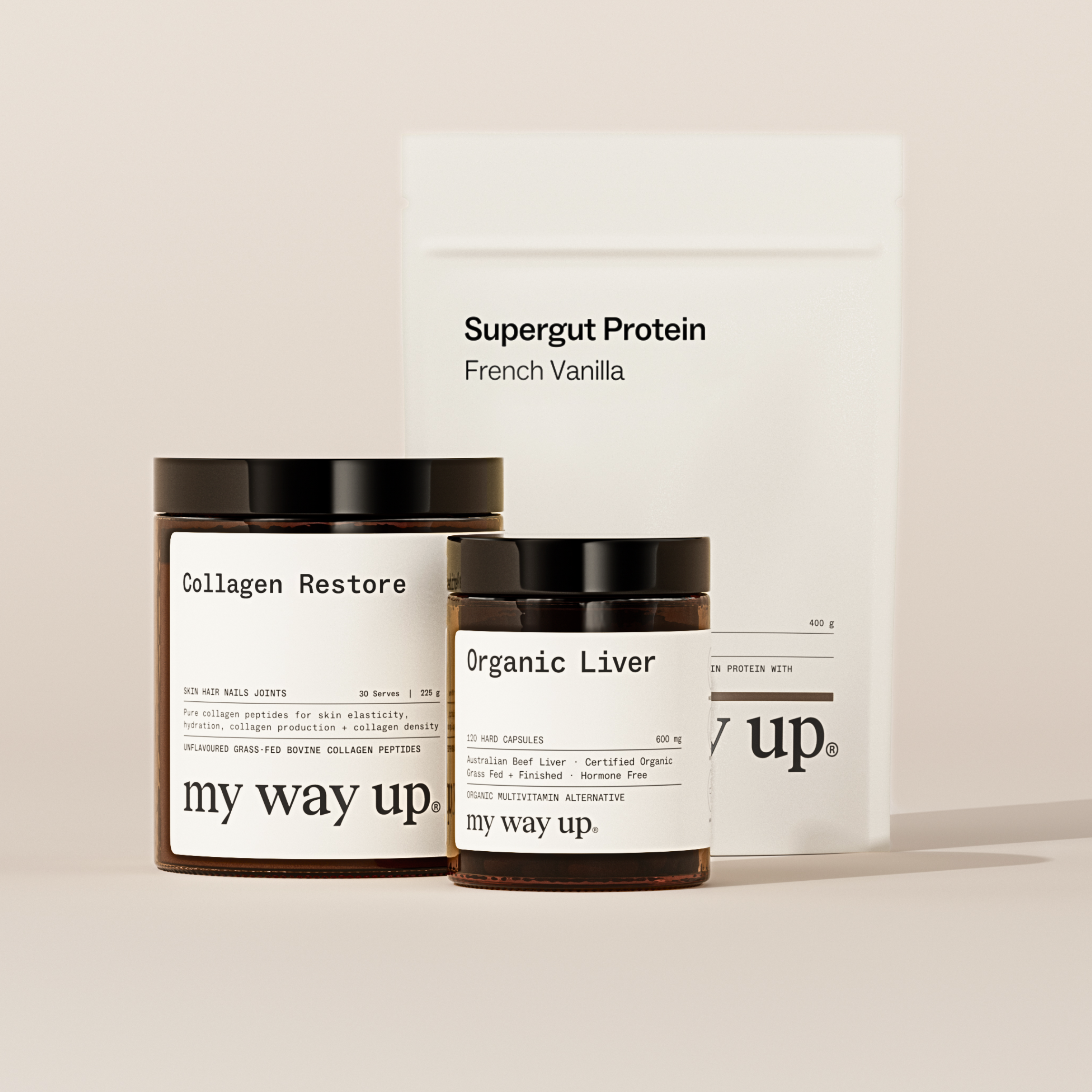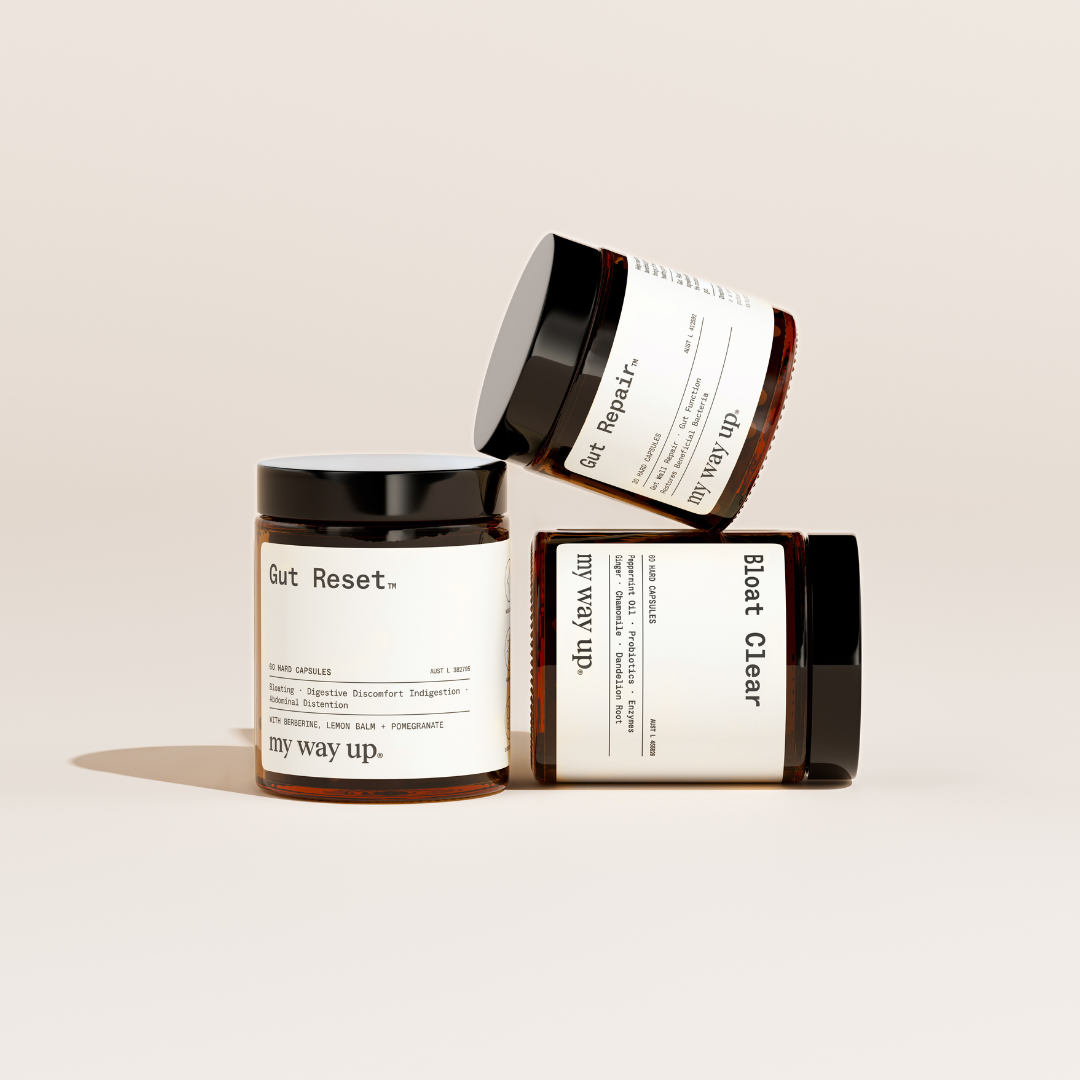Combatting Menopausal Weight Gain

Gut Smarter
Weight gain during menopause isn’t just about a slower metabolism—it’s also driven by hormonal shifts, especially the drop in oestrogen. This can lead to fat redistributing around the belly. It’s a common (and frustrating) part of the journey, but not something you’re powerless against. Read on to find what you can do about it.

Menopause + Weight Gain: What’s Really Going On?
Menopause is a natural transition that typically occurs around the age of 50. It impacts overall health and well-being, including noticeable changes in body composition and metabolic function.
What’s Behind Weight Gain—Especially Belly Fat—During Menopause?
The transition into menopause brings significant hormonal changes that can shift how fat is stored and how energy is used in the body. These changes include:
- A drop in estrogen levels
- A relative rise in androgens, due to changes in the androgen-to-estrogen ratio
Depending on your lifestyle and health status, these shifts can lead to:
- Increased abdominal and visceral fat (i.e. fat stored around internal organs)
- Metabolic changes, particularly in how your body handles sugars and fats—with visceral fat breaking down more readily (i.e. enhanced lipolysis), releasing excess free fatty acids into the bloodstream, which may contribute to insulin resistance and metabolic syndrome [1]
- Increased inflammation and reduced protection against oxidative stress [2]
- A drop in energy expenditure, including a lower basal metabolic rate [1]
- Loss of muscle mass and strength (i.e. sarcopenia) [3]
A Closer Look at Fat Metabolism During Menopause
On a cellular level, estrogen—especially estradiol—plays a key role in fat metabolism:
- Its decline downregulates genes involved in fatty acid beta-oxidation (i.e. the process of burning fat for energy in the mitochondria)
- As a result, the excess free fatty acids released from visceral fat aren’t efficiently used for energy
- At the same time, lipid synthesis (i.e. lipogenesis) increases, particularly in the liver and subcutaneous fat, driven by genes that promote fat storage
The outcome? Less fat burned for energy, more fat stored.
How you Can Act on Belly Fat—Lifestyle & Diet
What to Avoid
Foods Associated with Increased Inflammation and Insulin Resistance
- Ultra-processed foods, including processed meats like bacon and sausages—often packed with added sugars, unhealthy fats, and additives [4]
- High glycaemic index foods, such as sugary drinks and sweets—which spike blood sugar
- Refined carbohydrates, like white bread, pastries, and many packaged snacks—stripped of fibre and nutrients
- Fried foods—often containing trans fats
Why it matters?
Inflammation acts like a red-alert alarm blaring throughout your body—throwing off vital systems including your immune response, gut health, nervous system, and hormonal balance.
During perimenopause and menopause, your body naturally shifts toward a more inflammatory state. If left unchecked, this low-grade inflammation may increase long-term risks, including for neurodegenerative diseases later in life [5].
Severe Restrictive Diets
Drastically cutting calories might seem like a quick fix, but in reality, extreme diets (<800-900 kcal/day) can do more harm than good—both physically and mentally.
Why they’re not the answer:
- Risk of nutrient deficiencies—very low energy intake often means missing out on essential vitamins and minerals.
- Loss of muscle mass—low-calorie diets promote catabolism (i.e. muscle breakdown), which is especially problematic during peri- and postmenopause, when the risk of sarcopenia (i.e. muscle loss) increases [6].
- Metabolic “shutdown”—with limited fuel, your body switches to survival mode: it burns fewer calories, stores more fat, and energy levels drop. Over time, this contributes to the well-known yo-yo effect—weight regain after stopping the diet [7].
- Nutritional behaviour disruption—lower levels of leptin (i.e. the satiety hormone, produced by fat cells) and insulin modify appetite signals.
- Mood instability—with your nervous system already more sensitive due to hormonal shifts, extreme dieting may worsen feelings of anxiety and low mood [8].

A best-selling trio to support your weight wellness + gut health journey
What About Calorie Reduction Done Right?
In certain cases, a moderate, professionally guided reduction in calories can offer real benefits. When done properly, it may improve:
- Metabolic markers—including blood sugar, cholesterol, and triglycerides
- Insulin resistance—helpful for managing type 2 diabetes
- Body composition—especially reducing visceral and abdominal fat
- Healthy ageing—by reducing oxidative damage and supporting mitochondrial function (i.e. your cells' energy centres) [7]
Which Diets Show Promise?
In a 16-week randomised controlled trial involving obese postmenopausal women, two nutrient-dense eating patterns led to significant visceral fat loss—especially thanks to their high fibre content [9]:
- Mediterranean Diet—composed of 37% fat (particularly rich in monounsaturated fatty acids MUFAs, with olive oil and nuts at every meal), 18% protein and 45% carbohydrates
- Central European Diet—with 27% fat and 55% carbohydrates, high in dietary fibres from wholegrains, legumes, vegetables, and fruits
Naturally low in refined sugar, salt, and saturated fats, and rich in antioxidants and anti-inflammatory foods, both diets, showed strong benefits when followed consistently and balanced with lifestyle habits.
Healthy Habits to Adopt & Key Nutrients
Here’s how you can support your body through menopause and help counter the changes that promote fat accumulation—by focusing on three key pillars:
- Reducing inflammation and oxidative stress
- Supporting energy metabolism and preserving muscle mass
- Managing stress and improving sleep
Simple lifestyle habits and targeted nutrients can make a real difference—not just for your weight, but for your overall sense of balance and wellbeing.
Inflammation & Oxidative Stress
- Antioxidants
Oxidative stress naturally increases during menopause due to falling estrogen levels—this imbalance can drive both inflammation and fat accumulation. In fact, studies suggest that lower overall antioxidant capacity is linked to higher obesity rates in postmenopausal women [10].
Antioxidants help neutralise oxidative stress and improve lipid metabolism. They’ve also been shown to help regulate insulin levels, which can play a key role in preventing fat storage tied to metabolic disorders [11,12].
Key Antioxidants
- Vitamins A, C and E
- Selenium
- Carotenoids (pro-vitamin A)
- Phytochemicals like flavonoids and polyphenols
Where to Find Them:
- Fruits (especially berries, citrus),
- Vegetables (like spinach, carrots and tomatoes),
- Nuts (almonds, walnuts),
- Dark chocolate (>70% cocoa),
- Tea, coffee,
- Extra virgin olive oil,
- Red wine (in moderation)
Phytoestrogens
Phytoestrogens are plant-based compounds that resemble estrogen and can gently modulate its activity in the body—particularly useful during menopause, when natural estrogen declines.
Two notable phytoestrogens, genistein and daidzein (both isoflavones), also offer antioxidant effects that support metabolic health.
Where to Find Them:
- Soybeans,
- Soy products (like tofu, soy flour, and soy milk),
- Other legumes
- Anti-Inflammatory Foods & Supplements
Omega-3 Fatty Acids
Omega-3s are essential fats your body can’t produce on its own—meaning they must come from your diet.
The most beneficial forms include EPA (eicosapentaenoic acid) and DHA (docosahexaenoic acid), found mainly in marine sources.
Well known for their anti-inflammatory effects and their ability to improve insulin sensitivity, omega-3s help protect against metabolic syndrome and visceral fat accumulation—which are often heightened after menopause [1].
One study showed that supplementing with 900 mg of omega-3 per day over 6 months led to a significant drop in BMI (i.e. body mass index) and waist circumference in postmenopausal women [13].
Where to Find Them:
- Oily fish (like salmon, mackerel, sardines, herring, and cod liver)
Tip: Go for smaller fish to reduce exposure to heavy metals.
- Plant-based oils, nuts and seeds (like flaxseed, chia, walnuts, and canola oil)
Tip: Store oils in the fridge and avoid heating them to preserve quality.
- Supplements
Tip: check oxidation level—bad quality omega-3s can do more harm than good.
Omega-6: Keep it in Check
While omega-6 fatty acids are also essential, they tend to be pro-inflammatory when consumed in excess.
A better omega-3 to omega-6 ratio can reduce inflammation and support healthier fat metabolism.
Tip: Limit refined vegetable oils (like corn, sunflower, soybean oil), peanuts and peanut butter, fried and processed foods.
Vitamin D
A cross-sectional analysis (i.e. an observational “snapshot” of a population at a single point in time) of 292 postmenopausal women aged 50–79 years found that higher levels of 25(OH)D—the biological marker for vitamin D status—were inversely associated with body fat, BMI, and waist-to-hip ratio [14].
This suggests that women with greater adiposity may be more prone to vitamin D deficiency, potentially increasing the risk of metabolic disorders.
Why Vitamin D Matters?
Vitamin D plays a key role in immune modulation and inflammation reduction—both important for supporting healthy fat metabolism.
One study showed that daily supplementation with 1000 IU of vitamin D3 over 9 months led to a reduction in pro-inflammatory markers in postmenopausal women aged 50–65 [15].
How to Get It?
While your body can produce vitamin D through sunlight exposure, several factors—including season, skin tone, age, and lifestyle—can impact how much you actually synthesise. That’s why food sources and/or supplements are often needed, especially in older adults.
Best Sources:
- Vitamin D3 (cholecalciferol)— the most effective and bioavailable form, found in fatty fish (like salmon and sardines), cod liver oil, and egg yolks
- Vitamin D2 (ergocalciferol)—found in UV-exposed mushrooms and yeast; less bioavailable than D3
Tip: As a fat-soluble vitamin, vitamin D is best absorbed when consumed with healthy fats or in lipid-based formulations.
How Much Do You Need?
Although the recommended dietary intake (RDI) for adults aged 51–70 is 400–600 IU per day (10–15 µg/day), many health experts suggest aiming for 1500–2000 IU per day (37.5–50 µg/day) to maintain optimal blood levels—particularly in people at risk of deficiency [16].
Upper safe limit: 4000 IU per day (100 µg/day)
Curcumin
Found in turmeric, curcumin is a powerful compound that targets multiple biological pathways to help combat adiposity and support metabolic health [17]:
- Energy Expenditure—Promotes the browning of white fat cells, helping the body burn more fat by increasing thermogenesis (i.e. heat production)
- Enzymes—Activates fat-burning enzymes like AMPK (AMP-activated protein kinase), while inhibiting fat-storing enzymes such as ACC (acetyl-CoA carboxylase) and FAS (fatty acid synthase)
- Fat Cells Differentiation—Inhibits adipocytes maturation
- Lipid Metabolism—Supports balanced cholesterol levels and regulates fat synthesis and breakdown
- Immune Response—Lowers inflammation by inhibiting pro-inflammatory cytokines
One study showed that 500 mg of curcumin taken twice daily for 8 weeks significantly improved fasting blood glucose and lipid profiles in postmenopausal women [18].
Curcumin & Gut Health
The research also highlights the interaction between curcumin and the gut microbiota (i.e. your gut microbes)—regulating its composition, which influences metabolism, hormonal balance and immunity, all crucial for weight management [17].
Bioavailability
Curcumin is naturally poorly absorbed by the body. It breaks down quickly and is eliminated before it can have much effect.
How to boost it?
- Add a pinch of pepper—it contains piperine, which can enhance curcumin absorption by up to 2000% by blocking its breakdown [19].
- Choose supplements that use bioavailability-enhancing technologies, like liposomal or micellar nano-formulations [20].
Metabolic Health through Nutrients, Gut Microbiota & Muscle Mass
- The Role of Proteins
Blood Sugar Balance & Appetite Regulation
Protein—from whole foods or supplements like collagen—plays a vital role in managing:
- Blood glucose levels
- Insulin secretion
- Appetite and satiety
How?
Certain gut cells (called enteroendocrine cells) are stimulated by protein intake and trigger the release of hormones that help regulate metabolism and hunger [21–23]:
- GLP-1 (glucagon-like peptide 1)
- CCK (cholecystokinin)
- PYY (peptide YY)
- GIP (glucose-dependent insulinotropic polypeptide)
Muscle Mass, Exercise & Metabolic Rate
Protein is essential for maintaining muscle mass, which tends to decline with the natural drop in estrogen during menopause.
When paired with resistance training, protein helps [24]:
- Build and maintain lean muscle
- Boost your basal metabolic rate (i.e. the number of calories your body burns at rest)
- Support healthy weight management
Regular movement also supports [24]:
- A better body composition—more muscle, less belly fat
- Improved blood sugar control and insulin sensitivity
- Healthier cholesterol levels and blood pressure
How Much Protein Do You Need?
The standard RDA (recommended dietary allowance) is 0.8 g of protein per kg of body weight per day for adults.
But during menopause, ageing, or weight loss, a higher intake of 1.0–1.2 g/kg/day is often recommended to help preserve muscle mass and support metabolic health [3,11].
- The Gut Microbiota: A Key Player in Weight & Metabolic Health
Your gut isn’t just for digestion—your gut microbiota (aka. the trillions of microbes living in your digestive tract) is deeply involved in managing your weight, hormones, and metabolism.
Here’s how your gut bugs help you stay balanced [25]:
- Regulate gut hormones—affecting appetite, sugar metabolism and fat storage
- Support gut barrier integrity—helping prevent inflammation and immune dysregulation
Short-Chain Fatty Acids (SCFAs): Microbial Gold
Certain beneficial gut bacteria produce short-chain fatty acids (SCFAs) like butyrate and propionate when they ferment fibre in your diet.
These SCFAs boost levels of GLP-1 and GIP hormones—improving glucose tolerance and helping with appetite control and weight management.
Gut Integrity & Inflammation
When the gut barrier is compromised (aka. “leaky gut”), it can allow bacterial fragments to enter the bloodstream—triggering inflammation, which is linked to obesity, insulin resistance, and metabolic syndrome.
Gut microbiota can stimulate enteroendocrine L-cells and increase GLP-2 (glucagon-like peptide 2) secretion, which:
- Plays a key role in maintaining gut barrier integrity,
- Helps reduce chronic low-grade inflammation [26].
Prebiotics & Probiotics: Fuel & Allies for Your Gut
Prebiotics are plant fibres that feed your good gut bacteria:
- improving gut barrier function
- reducing inflammation
- regulating gut hormone production
Probiotics, from supplements or fermented foods, are beneficial bacteria. Certain strains have been shown to support gut health and metabolic function [27,11].
Tip: Strain and dosage matter—always check with your healthcare provider to make sure you’re taking the right one for your needs.

Sleep & Stress Management
Quality sleep and effective stress management play a vital role in reducing belly fat during menopause.
Both poor sleep and ongoing stress have been linked to increased systemic inflammation and hormonal imbalances—two major contributors to visceral fat gain.
In fact, poor sleep quality has been associated with higher levels of pro-inflammatory markers, such as interleukin-6 (IL-6), which is linked to higher visceral fat in postmenopausal women [28].
When stress ramps up inflammation, the relationship between sleep, stress, and inflammation can quickly become a vicious cycle.
Chronic stress, short sleep and poor sleep quality also affect the Hypothalamic-Pituitary-Adrenal (HPA) axis, increasing cortisol levels—a stress hormone that can be associated with abdominal fat accumulation [29].
- Exercise Practice
Both exercise and stretching interventions can improve sleep quality in postmenopausal women—boosting overall fitness is linked with better sleep outcomes.
- One study involving overweight postmenopausal women aged 50 to 75 found that those who exercised for at least 3 hours and 45 minutes per week in the morning reported fewer difficulties falling asleep over the course of a year, compared to those who exercised less than 3 hours weekly [30].
However, exercising in the evening appeared to have the opposite effect.
- Stretching also showed benefits—participants who practised regular stretching were less likely to rely on sleep medications and experienced fewer difficulties initiating sleep compared to their baseline before the study [30].
In addition, two “mind–body” techniques have emerged as valuable strategies.
Recent meta-analyses suggest that mindfulness practices and breathwork can significantly improve sleep quality, perceived stress, and overall mental wellbeing, in postmenopausal women and in the general adult population, respectively [31,32].
- Key Supplements
Magnesium
Magnesium (Mg) is an essential micronutrient that acts as a co-factor for hundreds of enzymatic reactions throughout the body. It plays a crucial role in processes ranging from energy production and muscle function to brain and bone health. [33].
While its role in ATP activation (the body’s energy currency) is well known, growing interest surrounds magnesium’s influence on the nervous system—especially during menopause, when stress and sleep disturbances become more common.
Although scientific consensus on the link between magnesium and sleep remains mixed, several observational studies associate adequate magnesium levels with better sleep quality [34].
Notably, clinical trials in older adults and postmenopausal women have shown improved sleep with magnesium supplementation in the range of 225–500 mg/day [35,34].
Dietary Sources:
Mainly found in green leafy vegetables, whole grains, legumes, and nuts.
However, due to the presence of antinutrients like phytates and oxalates in these foods—which can impair magnesium absorption—supplementation may be helpful.
Tip: To improve uptake, avoid taking your supplement with high-antinutrient foods.
Bioavailability Tips:
- Some other micronutrients, such as vitamins D and B6, can enhance Mg absorption [36]
- Choose organic, highly absorbable forms such as chelated-Mg (e.g. Mg bisglycinate), Mg-citrate or liposomal-Mg
- Avoid less tolerated inorganic forms, like marine magnesium, which may cause digestive upset in some individuals [37]
Saffron
Saffron, scientifically known as Crocus sativus, is a spice rich in bioactive compounds like crocin, safranal, and crocetin—all of which play a role in supporting brain function and mental wellbeing.
Studies suggest saffron may help [38]:
- Improve sleep duration and quality
- Reduce anxiety
- Ease mild insomnia symptoms
- Enhance mood
Its calming effects seem to come mainly from crocin and safranal, which interact with important neurotransmitter systems, including GABA and serotonin, that are linked to sleep regulation and anxiety. These effects appear particularly beneficial for people under higher stress.
Saffron is also a potent antioxidant and anti-inflammatory agent, protecting brain cells and supporting healthy nervous system function.
Beyond neurological benefits, saffron may support digestion and help regulate blood glucose, providing multiple health benefits.
Recommended Intake:
A daily dose of around 28 mg for 4 weeks has shown positive effects on insomnia and anxiety, with many users noticing improved sleep quality within the first week [39].
Adaptogenic Botanicals
Ashwagandha
Ashwagandha (Withania somnifera) is a medicinal herb long used in Ayurveda (i.e. traditional Indian medicine) to treat a wide range of conditions.
Today, it is well-studied for its benefits in managing stress, anxiety, and depression, as well as enhancing physical performance [40,41].
These effects are primarily attributed to its bioactive compounds—alkaloids and withanolides—which influence key physiological pathways including:
- Stress response—via the Hypothalamic-Pituitary-Adrenal (HPA) axis
- Neurotransmitter systems (e.g. GABA and serotonin)
Notably, ashwagandha has been shown to effectively lower cortisol levels, particularly morning cortisol [42].
Recommended Intake:
Scientific evidence suggests that a daily dose ≥600 mg of standardised extract for at least 8 weeks is most effective for supporting the nervous system and improving sleep. However, even 250 mg/day for 8 weeks has been found to significantly reduce cortisol and improve sleep quality in stressed, healthy adults [43].
Rhodiola
Rhodiola rosea is an adaptogenic plant known to enhance the body's resilience to stress, fatigue, and mental exhaustion.
It helps regulate the release of stress hormones (notably cortisol), while also stimulating cellular energy production by promoting ATP synthesis in mitochondria [44].
Acting on both prevention and relief, rhodiola is particularly useful in managing stress-related conditions such as burnout—helping to prevent acute stress from becoming chronic, and alleviating symptoms once they appear.
Recommended Intake:
Most clinical studies support an average dosage of 200 mg/day, typically for a minimum of 4 to 8 weeks to observe significant effects.
Synergistic effects
Combining magnesium with calming botanicals like adaptogens often results in synergistic effects, amplifying their benefits on the nervous system and promoting relaxation [45].
How we can help
Certain dietary supplements may support metabolic balance and weight management—especially when paired with healthy habits.
My Way Up® offers a range of formulas designed to target key physiological systems involved in energy metabolism, gut health, and emotional wellbeing. Let's dive into them below:
Weight Loss System
A smartly formulated blend aimed at improving:
- Muscle mass gain
- Metabolic health—glucose management
- Digestion and overall gut function
Key features:
- Slow digesting protein—for prolonged satiety and reduced cravings
- No refined sugar—helping to stabilise insulin response
- Solnul® prebiotic—to nourish beneficial gut bacteria
- Lactospore® probiotic—to support digestive comfort and reduce bloating
- Digestive enzymes—for easier digestion and better nutrient absorption
This all-in-one approach helps build lean mass (important for boosting metabolic rate) and supports gut-brain axis function—essential for managing appetite, inflammation, and energy balance.
This formulation highlights two key ingredients useful in addressing metabolic health and fat-lean mass balance:
- Bovine collagen peptides—help preserve lean mass and joint function, also may improve the secretion of the gut hormone GLP-1.
- Bimuno® prebiotic—known to stimulate gut Bifidobacteria, which are producers of short-chain fatty acids (SCFAs) [46]. These SCFAs, in turn, increase GLP-1 secretion [47].
As discussed above, GLP-1 plays a central role in regulating glucose levels and appetite. Together, these two key ingredients may contribute to better body composition and metabolic health outcomes.
A concentrated source of highly bioavailable vitamins and minerals, derived from organic beef liver, including:
- Vitamins A, D3, and E—key antioxidants and immune regulators, as seen above.
- Iron, zinc, and B vitamins—supporting immunity, metabolic health and hormonal balance.
Especially recommended if you follow a restrictive diet—as discussed above, a low-calorie diet should not be too drastic or followed without professional supervision, to avoid muscle loss and nutrient deficiencies.
Sleep + Stress
An integrative formula designed to calm the nervous system and support the gut-brain axis—both crucial for sustainable weight loss.
It includes:
- Adaptogens—Rhodiola and Ashwagandha to balance cortisol, promote resilience to stress and support emotional balance
- Calming botanicals—Chamomile and Lemon Balm to aid relaxation and sleep onset
- Magnesium—for nervous and muscular relaxation, and energy metabolism
- Saffron—for mood regulation and sleep improvement
The roles of magnesium, saffron and adaptogens are detailed in the above chapter on Sleep & Stress Management.
Key Takeaways
- Menopause changes the rules—but not your potential
Hormonal shifts affect metabolism, fat distribution, muscle mass, sleep, and mood. These changes are real, but they’re not irreversible!
- Weight management is multifactorial
Nutrition, gut health, sleep, stress, hormones, and physical activity are deeply interconnected. There’s no one-size-fits-all fix—it’s the synergy of these factors that makes the difference.
- Support your body with the right nutrients
Protein helps preserve muscle mass and regulate appetite.
Micronutrients—such as antioxidants, magnesium, and vitamin D—support metabolic health, mood, and anti-inflammatory responses.
Remember, supplements are here to support your lifestyle, not replace it.
- Exercise is your ally
Physical activity improves insulin sensitivity, preserves muscle, reduces visceral fat, and boosts mood and sleep.
Aim for a tailored routine that includes strength work, aerobic training, stretching, and mind-body practices like breathwork.
- Consistency and patience matter more than perfection
Small, consistent changes are more effective than all-or-nothing thinking. Give yourself time to build supportive habits rather than drastic short-term measures.
- It’s not just about weight—think lifestyle
It’s about feeling strong, balanced, and energised. Build a lasting lifestyle that supports your body through this transition, and be kind to yourself along the way.
Editorial Standards
My Way Up® has strict sourcing guidelines to ensure our content is accurate and current. We rely on peer-reviewed studies, academic research institutions, and medical associations.
This article is for informational purposes only and does not constitute medical advice. The information contained herein is not a substitute for and should never be relied upon for professional medical advice. Always talk to your doctor about the risks and benefits of any treatment. Learn more about our editorial standards here.






